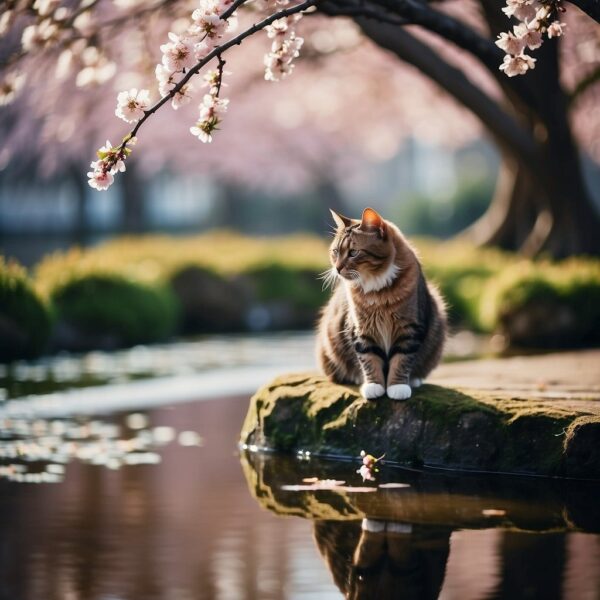
Japanese Bobtail Cats: the Charm of a Traditional Breed
The Japanese Bobtail cat is distinguished by its unique “bobbed” tail, which sets it apart from other feline breeds. This trait gives the tail a pom-pom appearance, likening it more to a rabbit’s tail than that of a typical cat’s. The breed’s history is deeply rooted in Japan, where it is not only a common house pet but also a cultural icon, appearing frequently in historical folklore and art.
Characteristically, Japanese Bobtails sport a sleek, soft coat and possess a physique that is both well-muscled and slender. Their expressive eyes and high cheekbones contribute to a distinctive face that many find quite enchanting. Known for their playful and intelligent nature, they are often sought after for their social and interactive behavior. In addition to their charming temperament, they have a noted history for being excellent in rodent control, making them highly valued historically in silk barns.
Key Takeaways
- The Japanese Bobtail is recognized for its unique, rabbit-like tail.
- These cats boast a slender and muscular build with a distinctive facial structure.
- They are celebrated for their playful behavior and historical significance in Japan.

Breed History
The Japanese Bobtail is a distinguished feline breed with deep roots in Japan’s cultural past, recognized for its unique bobtail. Significant for their historical presence in Japan and later adoption in Western countries, their journey from the Far East to international recognition tells a tale of tradition and appeal.
Origins in Japan
The Japanese Bobtail has existed in Japan for centuries with evidence dating back to the 600-700 AD era. Initially imported to assist Buddhist monks in controlling the rodent population, these cats swiftly integrated into Japanese society and folklore. They are most notable for their distinctively short and kinked tails, which resemble a rabbit’s tail more than that of a typical cat. This genetic trait is a unique feature of the breed and is a result of a natural mutation. Throughout history, they have been depicted in various forms of traditional Japanese art, affirming their status as cultural icons.
Western Recognition
The breed’s journey to Western recognition began in the mid-20th century. The Japanese Bobtail was officially registered in the 1960s, signifying its acceptance beyond its native Japan. Breeders and cat enthusiasts in the western hemisphere took notice of these graceful creatures, captivated by their history, distinctive appearance, and lively temperament. The American Cat Fanciers Association (CFA) subsequently provided the Japanese Bobtail with championship status, propelling its popularity among cat lovers worldwide.
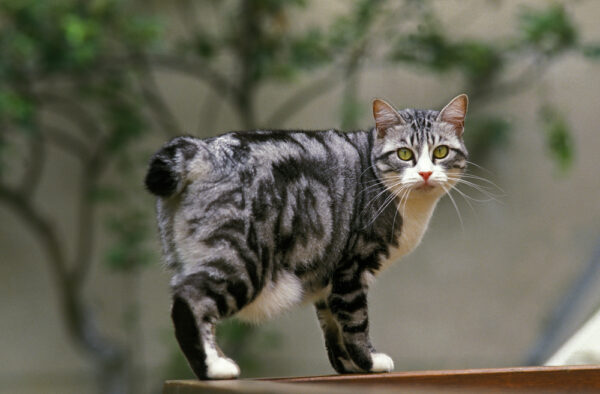
Physical Characteristics
In assessing the physical characteristics of the Japanese Bobtail, one is immediately struck by their distinctive tail, varied coat colors and patterns, and a unique body type that differentiates them from other feline breeds.
Distinctive Tail
The Japanese Bobtail is best known for its short, “pom-pom” like tail, which is a result of a natural genetic mutation. Each tail is unique to the individual cat and can have kinks or curves.
Coat Colors and Patterns
Their coat comes in a wide array of colors and patterns including, but not limited to, white, black, red, and cream. Common patterns encompass solid, bicolor, tricolor (calico), and tabby. Another notable pattern includes the ‘Mi-Ke’ (pronounced “mee-keh”) or tricolor pattern often seen in females.
Body Type and Size
The Japanese Bobtail boasts a medium-sized frame with strong and muscular hind legs that are longer than the front, giving them a powerful, athletic appearance. They typically weigh 5-10 pounds, and reach a length up to 14 inches. Their build contributes to their agility and playful behavior.
Temperament and Behavior
The Japanese Bobtail is renowned for its interactive nature, high energy levels, and exceptional adaptability, making it an excellent companion for various household dynamics.
Social and Interactive
Japanese Bobtails thrive on interaction; they form strong bonds with their guardians and actively seek out human company. They are sociable and are known to be vocal, often engaging in conversation with their human family members.
Playfulness and Energy
This breed exhibits a notable playfulness that persists well into adulthood. Japanese Bobtails possess considerable energy, often displaying zestful enthusiasm during playtime. Their spirited antics are a delight to observe.
- Playful Behaviors:
- Chasing toys
- Fetching
- Interactive games
Adaptability
Japanese Bobtails adapt readily to new environments and situations, showcasing impressive resilience. They handle changes with grace, whether it’s a house move or the introduction of new family members. This adaptive trait ensures they are comfortable and confident in most settings.
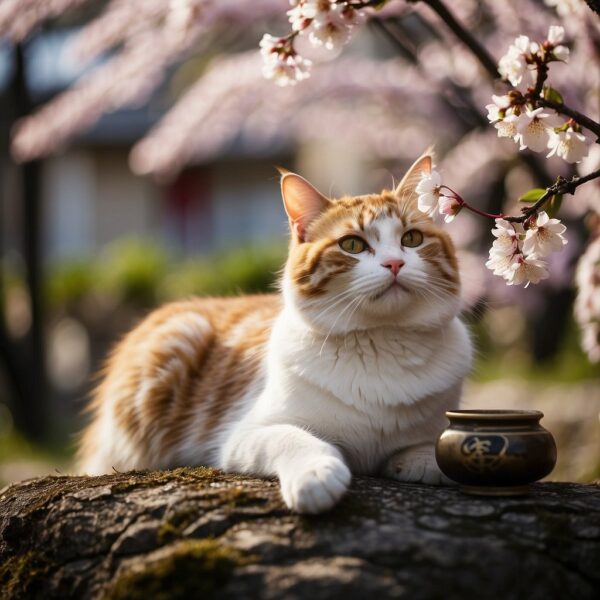
Japanese Bobtail Cat Health and Lifespan
Japanese Bobtail cats generally boast a lengthy lifespan and are known for their robust health. However, like all breeds, they may be susceptible to specific genetic conditions and common feline health issues.
Genetic Predispositions
The Japanese Bobtail breed does not commonly suffer from many genetic health problems. They are, however, prone to a hereditary condition called Manx syndrome, a collection of birth defects that may occur due to the gene that causes their unique tail configuration. This syndrome is rare and does not affect every bobtail cat.
Common Health Issues
Japanese Bobtails are susceptible to the same common health issues that can affect any domestic cat. These include:
- Dental Disease
- Obesity
- Kidney Disease
- Heart Disease
- Hyperthyroidism
Cat parents should be vigilant for any signs of these common ailments and maintain regular veterinary check-ups to ensure early detection and treatment.
Care and Wellness
Caring for a Japanese Bobtail involves routine practices to promote a long and healthy life:
- Diet: Maintain a balanced diet to prevent obesity.
- Exercise: Ensure regular playtime to keep your cat active and engaged.
- Grooming: While they typically have a low-maintenance coat, a weekly brush can help prevent matting (more frequently during shedding season).
- Veterinary Care: Annual check-ups with the vet help to detect and treat any health issues early.
By adhering to these care guidelines, cat parents can contribute to their Japanese Bobtail’s overall good health and longevity.
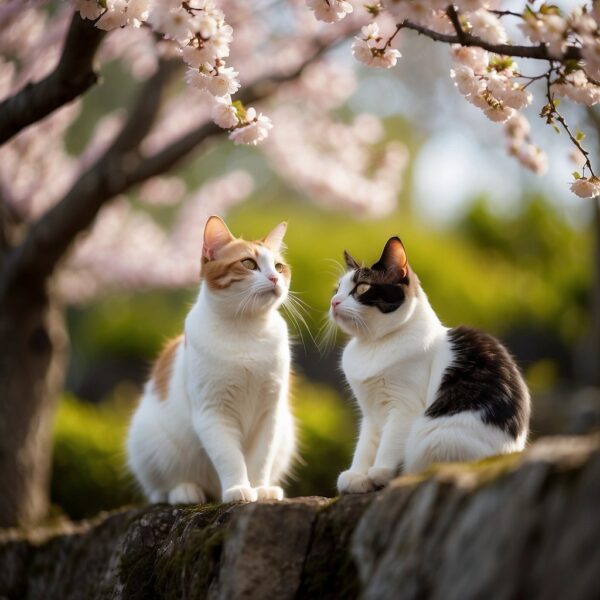
Japanese Bobtail Cats Breeding and Genetics
The genetics of the Japanese Bobtail influence both its distinct features and overall health. Breeders prioritize maintaining the breed’s hallmark traits, such as its pom-like tail, while ensuring genetic diversity and monitoring kitten development throughout breeding programs.
Breeding Practices
Japanese Bobtail breeders focus on retaining the breed’s unique physical characteristics, particularly the short, curled tail. Selective breeding practices ensure that the bobtail trait, which is a result of a genetic mutation, is expressed consistently. The breeding process also involves health screenings to prevent genetic disorders from being passed on to offspring.
Genetic Diversity
Maintaining genetic diversity within the Japanese Bobtail population is crucial to minimize the potential for hereditary health issues. Utilizing a varied gene pool helps sustain the breed’s vigor and reduces the risk of inherited conditions often associated with more closed breeding practices.
- Common Genetic Tests:
- Test for long-haired gene mutations
- Health screening for specific breed-related conditions
Kitten Development
Kitten development is carefully observed by breeders to ensure they are exhibiting the physical and behavioral traits characteristic of the Japanese Bobtail. Growth milestones are tracked, with attention given to diet and exercise, which can influence size and health.
- Key Developmental Milestones:
- Weaning
- Socialization
- Introduction to solid foods
- Vaccinations and veterinary examinations
Cultural Impact of Japanese bobtails cats
The Japanese Bobtail cat holds a unique place in history, ingraining itself as a symbol of good luck and prosperity in Japanese folklore, and extending its influence to attain global recognition for its distinctive characteristics.
Japanese Folklore
The Japanese Bobtail is intricately linked with Japanese folklore, where it is often depicted as a bringer of good fortune. Maneki-neko, the beckoning cat figurine commonly found in Japanese businesses, is modeled after this breed and believed to attract wealth and good luck. Additionally, these cats feature prominently in various historical art forms, including woodblock prints and paintings, underlining their revered status in Japanese society.
Global Popularity
Over time, the Japanese Bobtail has gained international popularity for its unique appearance, particularly its short, “pom-pom” like tail. This breed was officially recognized in North America by major cat fancier associations in the late 20th century, subsequently leading to a rise in their global presence. The breed’s playful demeanor and sociable nature, alongside its storied past, continue to endear it to cat enthusiasts worldwide.
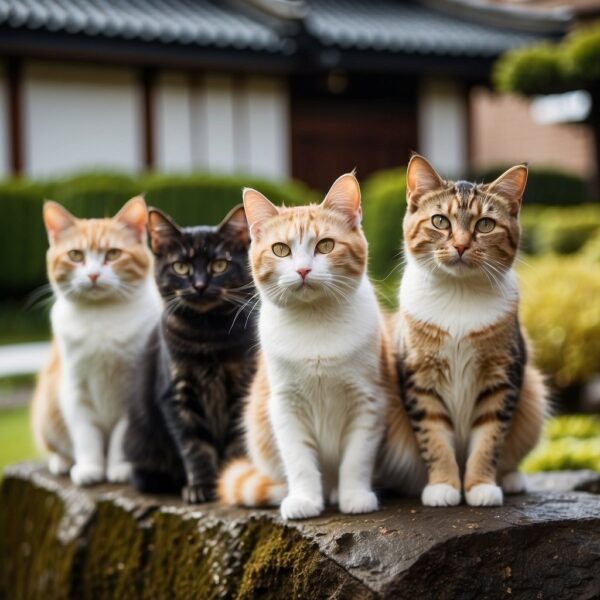
Frequently Asked Questions
In this section, readers will find concise answers to common inquiries about the Japanese Bobtail cat, a breed known for its playful temperament and distinctive short tail.
What are the typical personality traits of Japanese Bobtail cats?
Japanese Bobtail cats are generally playful, charming, intelligent, and outgoing. They are known for their affectionate and interactive nature, often engaging in games and activities with their owners.
How does the cost of a Japanese Bobtail cat generally range?
The price of a Japanese Bobtail cat typically ranges from $800 to $2,000, depending on factors such as pedigree, age, and color.
What are some common health problems in Japanese Bobtail cats?
Japanese Bobtail cats are relatively healthy, though they can be prone to certain genetic conditions like other breeds. It is important for potential guardians to seek reputable breeders who utilize responsible breeding practices.
How long is the average lifespan of a Japanese Bobtail cat?
The lifespan of a Japanese Bobtail cat generally ranges from 9 to 13 years or more, given proper care and regular veterinary check-ups.
What variety of colors do Japanese Bobtail cats come in?
Japanese Bobtail cats come in a variety of colors and patterns, including solid, bi-color, and tri-color variations. The coat can be either shorthair or longhair.
Are Japanese Bobtail cats considered to be a rare breed?
Japanese Bobtail cats are not extremely rare but are considered less common than some other breeds, partly due to their distinct physical characteristics and cultural significance in Japan.